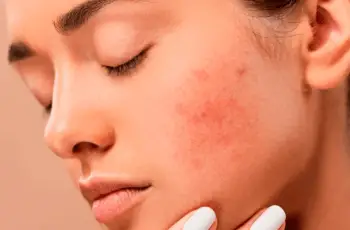
The Science of Sebum and the Sebaceous Glands
Sebum is a natural oil that everybody produces at different levels depending on their skin type. If you have ever looked in the mirror and noticed a shiny glow across your face, you have seen your skin’s sebum. While oily skin can feel like a nuisance, and can clog pores, the oil on your skin – sebum – is actually beneficial in many ways. Read on to learn all about the science behind oily skin and how sebum impacts your skin health. Be sure to take the Baumann Skin Type quiz, because most people guess their skin type incorrectly! Find out if your skin is oily or dry for free today!
What is sebum?
Sebum is an oily substance produced by small glands in the skin called sebaceous glands. Sebum coats the skin’s surface and provides a protective barrier against the environment. The main role of sebum is to keep the skin supple and prevent water loss. It also transports antioxidants like vitamin E to the skin’s surface. The average adult produces around 1 mg of sebum per 10 cm2 of skin every 3 hours. This naturally produced oil is essential for healthy skin hydration and barrier function.
What are the Sebaceous Glands?
Sebaceous glands are tiny glands found inside hair follicles that produce and secrete sebum. There are sebaceous glands distributed throughout the skin, except for the palms of the hands, soles of the feet, and the lips. The greatest concentration is on the scalp and face. Sebaceous glands are made up of special sebum-producing cells called sebocytes. As sebocytes mature, they accumulate lipids and increase dramatically in size before eventually releasing sebum onto the skin’s surface.
What is Sebum made of?
Sebum contains a mixture of lipids, including triglycerides, wax esters, squalene, free fatty acids, and small amounts of cholesterol. Two of the main players are triglycerides and squalene. Triglycerides make up the largest proportion of sebum – around 57.5%. They are broken down by skin bacteria into free fatty acids, some of which have antibacterial effects. Squalene makes up around 12% of sebum, and it acts as a powerful antioxidant. Unfortunately, it easily oxidizes into comedogenic squalene peroxide when exposed to air. Some other antioxidants in sebum are Coenzyme Q10 and Vitamin E. Other components like wax esters and fatty acids contribute to the skin barrier.
Does sebum clog pores?
While sebum is important for skin health, excess oil production can lead to clogged pores and acne breakouts. A key component of sebum is squalene, which oxidizes when exposed to air. The oxidation product, known as squalene peroxide, is comedogenic and can clog pores. Clogged pores combined with acne-causing bacteria can trigger the inflammatory breakouts associated with acne. Those with excess sebum production or “very oily skin” are at greatest risk for pore-clogging and acne breakouts.
Does your diet change your sebum?
Research shows that diet impacts sebum production. For example, high sugar diets have been associated with increased sebum secretion. One study found that males who consumed low glycemic diets had changes in their sebum fatty acid composition. Other research suggests that components of Western diets, like palmitic acid from dairy and meat, may activate inflammatory pathways linked to acne. While more studies are needed, it appears that sticking to a low sugar diet with less dairy and meat may help reduce excessive sebum production.
Sebum and the microbiome
The mixture of microbes living on the skin is known as the skin microbiome. The makeup of sebum directly impacts which bacteria can grow. Sebum provides a food source for certain microbes, like Cutibacterium acnes, which digest various fats. C. acnes releases inflammatory free fatty acids that contribute to acne. On the other hand, sebum’s fatty acids have antibacterial effects against C. acnes and other microbes. The effect your sebum will have on your face’s microbiome depends on factors like your skin type, your diet, and your lifestyle.
Stress and sebum production
Stress hormones are known to stimulate sebum production. For example, corticotropin-releasing hormone (CRH) binds to receptors on sebaceous glands and increases sebum secretion. CRH also ramps up conversion of precursor molecules into testosterone, which may further drive increased oil production. Other stress-associated molecules can also directly enhance sebum secretion. This helps explain why stress often triggers oily skin and acne flares. Using stress management techniques may help control stress-induced Sebum production.
Antioxidants in sebum
In addition to its protective moisturizing properties, sebum contains antioxidants that defend against oxidative damage from free radicals. The main antioxidant present is vitamin E. Vitamin E is fat-soluble, so sebum provides a perfect delivery system to transport it to the skin’s surface. Other antioxidants like coenzyme Q10 are also found in sebum. These antioxidants protect the skin from oxidative stress and UV radiation.
Sebum and skin cancer
While sebum mainly guards against dryness, it may also protect from skin cancer development in some cases. Areas of skin with minimal sebaceous glands, like the lips, are prone to dryness and have a higher risk of certain skin cancers. On the other hand, when sebum oxidizes on the skin it can itself create free radicals, this is one of the reasons it is important to wash your face when it has been greasy for a while.
Why do you need to wash sebum off your face?
While a thin film of sebum might protect you during the day, excess oil can cause breakouts and a greasy appearance. Sebum, sweat, dead skin cells, and environmental pollutants can combine to clog pores and create a breeding ground for acne-causing bacteria. That’s why it is recommended to wash your face twice a day – this removes excess sebum, debris, and germs from the skin’s surface. Using a cleanser that compliments the skin’s natural pH is ideal. Here are some great antibacterial and salicylic acid cleansers:
[[C01, C08]]
Is sebum occlusive?
Sebum prevents water evaporation from the skin’s surface, but is not as occlusive as petroleum-based ingredients. However, it does provide occlusive properties that reduce water loss. Even though it is not completely occlusive, a film of sebum on the skin’s surface slows down evaporation and provides moisturizing effects. Those with very oily skin types rarely suffer from dryness because their sebum production creates an occlusive layer that locks in hydration. If you have combination skin, you might only have oily skin sometimes.
Non-comedogenic skin care for oily skin
If your skin is oily and you don’t want to include any comedogenic ingredients in your skin care routine, I have recommendations for you! This collection of non-comedogenic skin care products was curated specifically for acne-prone and oily skin types that need to closely regulate the sebum on their skin.
Make sure to take the Baumann Skin Type Quiz to only buy the best products for your skin today!


